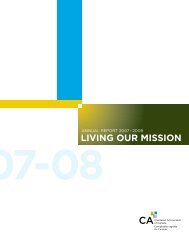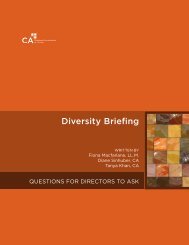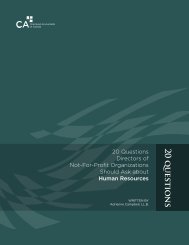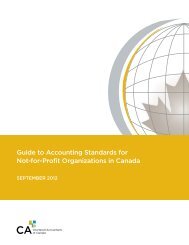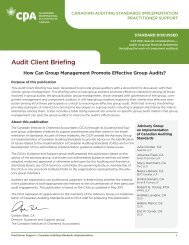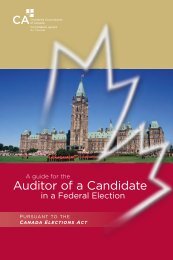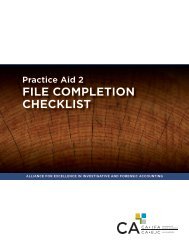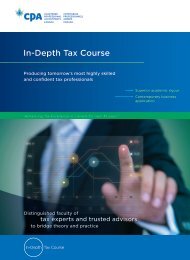20 Questions - Canadian Institute of Chartered Accountants
20 Questions - Canadian Institute of Chartered Accountants
20 Questions - Canadian Institute of Chartered Accountants
You also want an ePaper? Increase the reach of your titles
YUMPU automatically turns print PDFs into web optimized ePapers that Google loves.
Operational and Capital Planning and Budgeting y continued z18risk and a “can do” spirit. As part <strong>of</strong> a bold strategy, executed with skill, competenceand dedication it can support the achievement <strong>of</strong> extraordinary results.Poorly planned and managed it can be problematic or disastrous.Recommended practices• The budget philosophy is compatible with the organization’s risktolerance policy• The board recognizes its fiduciary responsibility by approving a budget thatis compatible with the organization’s budget philosophy16. What does the board need to know beforeapproving the operating plan and budget?Before the board approves the operating plan, it needs to review the budget forreasonableness. This includes comparing the numbers with the current and prioryears, knowing the assumptions on which the budget was based and understandinghow the numbers were developed.The budget summary presented to the board should provide comparative informationshowing the percentage and dollar amounts <strong>of</strong> increases and decreasesbetween years and explanations <strong>of</strong> significant changes. If the budget is approvedbefore the current year has ended (which is the best practice) the current yearnumbers may be an “outlook” based on the most recent actual numbers plus anestimate for the balance <strong>of</strong> the year.Budgeting should also include cash flow projections that show projectedreceipts, payments and bank balances. Any shortfalls may require borrowingand surpluses should be invested to earn interest. Managing cash flow andinvesting surpluses and endowments require the attention <strong>of</strong> the board whichmay appoint an investment committee to approve investment policy and towork with staff and (when appropriate) outside investment advisors.A good budget reflects the risk that revenues can be more or less than anticipated,recognizes the need to fund core costs and has the flexibility to adjustprogram expenditures to available funding. It is important for the board toknow how the budget for each item <strong>of</strong> revenue and expense was calculated andthe assumptions on which the calculations were based. There are two mainreasons for this. Firstly, it provides explanations that management and theboard can use to decide if the budget items are reasonable and realistic beforeapproving them. Secondly, it makes it easier to explain variances between actualand budgeted amounts as the year progresses – particularly if the budget iscalendarized.Recommended practices• The budget report presented to the board provides comparative information• The budget includes a cash flow summary• The budget includes plans for investing and borrowing• The assumptions and calculations behind budget items are documented• Costs and revenues are calendarizedBudget report columns• Last year – actual• Current year – outlook• Next year – budget• Dollar change between current and next year• Percentage change between current and next yearCalendarizationAlthough budgets are usually prepared for one-year periods,they can provide useful information over shorter periods if theyare “calendarized”. By estimating and recording the amount theorganization expects to receive or pay in each month it is possible toproduce reports comparing monthly and year-to-date actual amountsto budgets for the same periods. This also makes it easier to identifyand deal with variances from budget as they occur rather thanwaiting to the end <strong>of</strong> the year.Calendarization can also provide the basis for projecting monthlycash flow (receipts and payments) and end-<strong>of</strong>-month bank balances.






